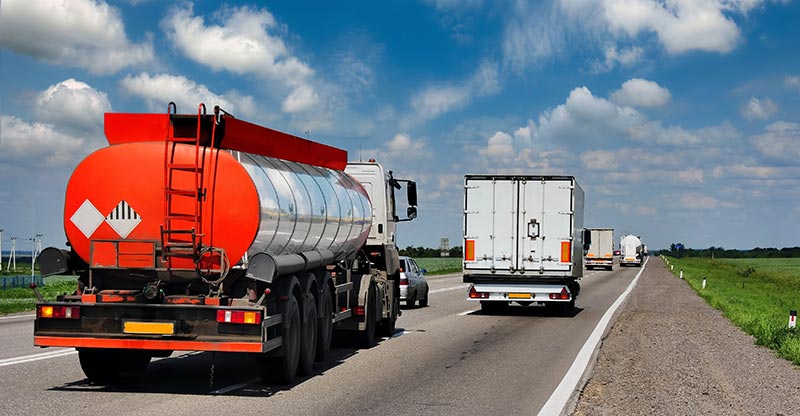The trucking industry has been struggling with driver and vehicle safety over the years, with truck driving widely considered one of the deadliest occupations in the US. But those most at risk aren’t truck drivers, but those who share the road with them.
In one especially tragic accident, seven people were killed in Gainesville, Florida when a tractor trailer collided with another vehicle and passed through an interstate center divider. The truck struck a church van transporting children and teenagers on their way to a youth outing at Disney World. Five children in the van died, as well as the van’s driver and the driver of the truck who caused the accident.
The cause of the accident remains under investigation, but Florida news organizations have unearthed evidence indicating that the driver had a spotty driving record, having been ticketed in at least five states for violations including speeding and operating an unsafe vehicle.
The accident is only one of many data points showing how the safety of the public is being impacted by the trucking industry. New regulations, overworked drivers, and aging fleets of big rigs have opened trucking companies up to potentially expensive lawsuits from the victims of trucking accidents, and even the truck drivers themselves.
Drivers are expected to work longer hours than ever, increasing the risk of a truck accident.
As demand for faster shipping continues to grow, pressure is mounting on truckers to drive longer distances and work longer days. Many well-off Americans consider 8-hour days to be the norm. But for truck drivers trying to support their families, 16-hour days aren’t unusual during high-demand seasons, pushing them to the limits of their endurance.
Longer work hours, with many spent on the road engaged in monotonous activity, are a potent recipe for disaster. The risk is especially high for long-haul drivers, more than half of which routinely violate US regulations by working over 50% more hours than the average US worker.
Overworked drivers also exacerbate safety risks inherent to large tractor trailers. With longer stopping distances while pulling a load, and slower response times to sudden changes in road conditions, an exhausted driver will have even less of a chance to avoid an accident. Sleep-deprived truckers regularly make the news after veering into roadside construction, concrete dividers, or other vehicles.
Drowsy driving is often compared to drunk driving, with multiple studies confirming the shared lack of alertness and reaction speed. Even if the truck driver awakens in time to see an imminent threat, the driver will be in no condition to properly assess the danger and safely respond to it.
Current pay schemes force drivers to work for unsafe lengths of time.
One of the major factors putting drivers at risk is the accepted standard pay practices across the entire trucking industry. Drivers are paid by the mile driven, rather than by the hours they are “clocked in” on the job. If traffic adds another 30 minutes to a 50-mile delivery that usually takes only an hour to drive on average, the driver will still only be paid for the 50 miles driven.
This pay scheme extends to time spent at a loading dock. Truckers aren’t compensated for the time it takes to load the truck, despite the fact they may assist with the loading process. At best, it’s a delay of minutes before the driver can get back out on the road. But the wait more often than not takes hours, delaying the start of driving and extending their workday. Emergency situations, such as an accident or the truck breaking down mid-haul, are also generally not compensated for.
Electronic logging devices increase the pressure on drivers to perform, leading to driving at unsafe speeds and causing serious accidents.
In 2017, Federal laws mandating the installation of electronic logging devices (ELDs) in delivery trucks went into effect. The devices are intended to guarantee that drivers do not spend more than 11 hours on the road in a 14-hour window. They also ensure that time on the road is accurately tracked, preventing drivers from falsifying logbook entries. But despite the 2017 installation requirements, 31% percent of fleets reported a year later that they still used paper logbooks in non-compliance with the laws.
From a management perspective, ELDs promised to greatly boost efficiency among drivers. From a safety perspective, the law was intended to reduce the time truck drivers spend on the road. But in fact, the law has only increased pressures compelling drivers to stay on the road.
While industry experts suggest that drivers should expect wait times of two hours, on average, at shipping docks. But a survey of 257 drivers by DAT Solutions revealed that just under two-thirds of those surveyed experienced detention times of three hours or more.
KeepTruckin, one of the leading manufacturers of ELDs, has stated that drivers who have experienced prolonged wait times are far more likely to drive faster. Speeding is the most frequently reported driver-related factor in trucking accidents across the US. Some drivers admit to taking greater risks because ELDs are more thorough and accurate at tracking the time they can legally spend on the road.
Distracted driving incidents caused by mobile devices and other factors remain a growing concern.

Distracted driving is responsible for a growing number of trucking accidents. According to the Federal Motor Carrier Safety Administration (FMCSA), this factor was one of the leading causes of death among truck drivers in 2017.
State and federal regulations have sought to limit possible sources of distractions to commercial drivers. Much focus has been placed on personal and company-issued mobile or hand-held devices that could pull a driver’s attention away from the road. Companies and drivers can be fined for the use of mobile devices while driving, even for work-related uses, or when using work-specific devices. Additionally, drivers can be placed “out-of-service” for violations and lose their qualifications. Carriers cited for repeat offenses suffer reduced ratings in the FMCSA’s Safety Measurement System. But despite penalties that some states are increasing in severity, distracted driving continues to challenge drivers within the industry.
A January 2019 trucking accident in Clovis, California is a clear example of how a single moment’s distraction can result in disaster. While driving at night, a trucker admitted to being distracted by his cell phone in the moments before he lost control of his semi-truck and crashed into an apartment and damaging five cars.
While mobile phones are one of the most obvious distractions, they are not the only possible distraction. A family in Holland, Michigan has sued a delivery company and one of its drivers for a 2018 trucking accident. The driver was distracted because they were adjusting their air conditioner, failing to notice that traffic ahead was stopping for a red light until it was too late, striking two vehicles and killing the mother of the family.
Driver-facing cameras are touted as a solution to distracted driving and other unsafe behaviors.
To combat recklessness behind the wheel, many carriers are installing driver-facing cameras in their trucks in concert with road-facing cameras. This can both prove that a driver was blameless for an accident, or show that distracted driving, fatigue, or worse were contributing factors.
But this technology is not required by law, which has slowed down the adoption of these systems. In addition, many truckers have expressed misgivings about cameras monitoring their every move. Their concerns are brought about in part by employers choosing to install systems without informing or consulting with the drivers themselves.
Aging trucks present unique safety risk to drivers and other vehicles on the road.
With consistent maintenance, a long-haul tractor trailer can put on millions of miles before it ends its service. Many trucks today start as part of a new addition to a large carrier fleet, but after a number of years in service, these trucks are often sold off to smaller carriers or independent drivers. The truck can expect hundreds of thousands more miles on the road before it requires a complete overhaul or replacement.
Because of the wear and tear these vehicles experience, proper maintenance is critical to ensure the safety of drivers, and other vehicles on the road. But some individuals and companies attempt to cut these expensive corners. Most notably, Amazon came under fire in 2018 for operating trucks that were suffering from a lack of maintenance. Drivers described vehicles with bald tires, broken rear and side-view mirrors, faulty brakes, and more. But the corporation stated that they were not technically responsible for the repairs, blaming the smaller delivery companies it contracts for failing to maintain their trucking fleets.
Newer trucks incorporate new safety technologies, but adoption remains slow and fraught with difficulties.
Because delivery trucks face constant use, abuse, and attrition, large carriers frequently replace aging machines with newer hardware out of necessity. Forward-collision warning and automatic emergency braking are two features being pushed in modern passenger vehicles, and newer commercial tractor trailers will incorporate similar solutions. Many newer trucks offer blind-spot warning systems, allowing truckers a better view of what’s around them.
Unfortunately, these technologies will remain comparatively rare in current trucking fleets for the time being. Most big-rigs in operation predate these systems by years, if not decades, meaning that retrofits are difficult at best, if not impossible.
Push back within the industry is also slowing the adoption of new safety technologies. Historically, trucking companies have been resistant towards government-issued mandates, stating that safety systems do not replace alert and experienced drivers behind the wheel. But with the workforce shrinking, and current drivers facing overwork, it may not have enough of either to stave off the adoption of more safety technology, including self-driving vehicles.
Commercial trucking faces an onslaught of lawsuits and penalties as it continues to struggle with new laws and safety regulations.
Many trucking accidents do involve factors outside of a commercial driver’s control, ranging from the drivers of passenger vehicles, to road conditions, and even how loads were secured within their trailers. But many other accidents can be tied directly to truck driver conduct, and even the policies of their employers, leaving carriers vulnerable to expensive litigation.
Trucking accidents are among the most costly and deadly accidents to happen on the road, with liability for property damage and medical costs often reaching into the millions. With the industry failing to address overwork and fatigue, and challenged by new laws and safety technologies, future lawsuits could become more costly.



